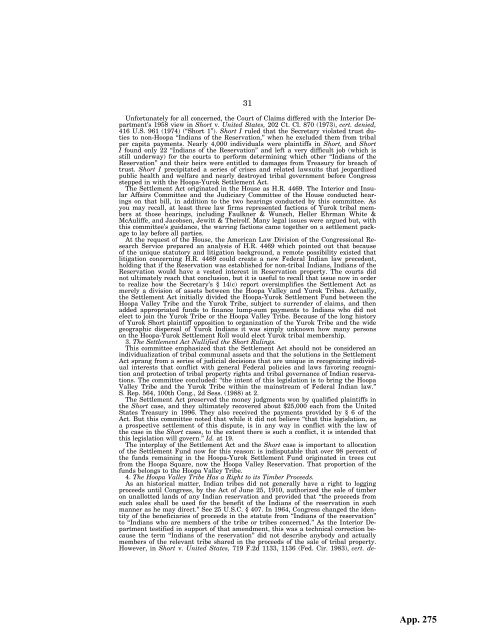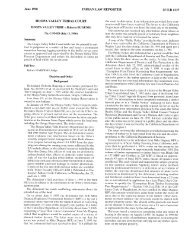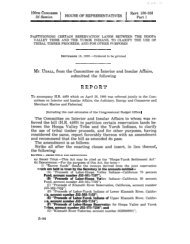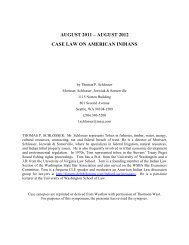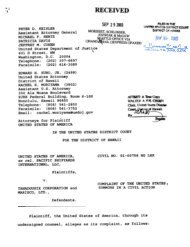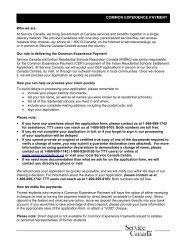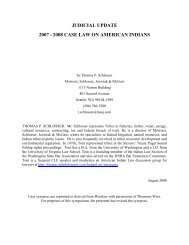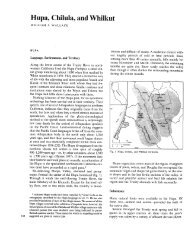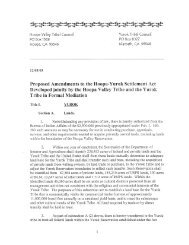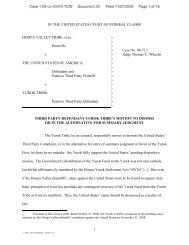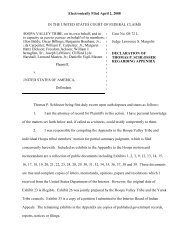Hoopa appendix supporting summary judgment - Schlosser Law Files
Hoopa appendix supporting summary judgment - Schlosser Law Files
Hoopa appendix supporting summary judgment - Schlosser Law Files
You also want an ePaper? Increase the reach of your titles
YUMPU automatically turns print PDFs into web optimized ePapers that Google loves.
31<br />
Unfortunately for all concerned, the Court of Claims differed with the Interior Department’s<br />
1958 view in Short v. United States, 202 Ct. Cl. 870 (1973), cert. denied,<br />
416 U.S. 961 (1974) (‘‘Short 1’’). Short I ruled that the Secretary violated trust duties<br />
to non-<strong>Hoopa</strong> ‘‘Indians of the Reservation,’’ when he excluded them from tribal<br />
per capita payments. Nearly 4,000 individuals were plaintiffs in Short, and Short<br />
I found only 22 ‘‘Indians of the Reservation’’ and left a very difficult job (which is<br />
still underway) for the courts to perform determining which other ‘‘Indians of the<br />
Reservation’’ and their heirs were entitled to damages from Treasury for breach of<br />
trust. Short I precipitated a series of crises and related lawsuits that jeopardized<br />
public health and welfare and nearly destroyed tribal government before Congress<br />
stepped in with the <strong>Hoopa</strong>-Yurok Settlement Act.<br />
The Settlement Act originated in the House as H.R. 4469. The Interior and Insular<br />
Affairs Committee and the Judiciary Committee of the House conducted hearings<br />
on that bill, in addition to the two hearings conducted by this committee. As<br />
you may recall, at least three law firms represented factions of Yurok tribal members<br />
at those hearings, including Faulkner & Wunsch, Heller Ehrman White &<br />
McAuliffe, and Jacobsen, Jewitt & Theirolf. Many legal issues were argued but, with<br />
this committee’s guidance, the warring factions came together on a settlement package<br />
to lay before all parties.<br />
At the request of the House, the American <strong>Law</strong> Division of the Congressional Research<br />
Service prepared an analysis of H.R. 4469 which pointed out that because<br />
of the unique statutory and litigation background, a remote possibility existed that<br />
litigation concerning H.R. 4469 could create a new Federal Indian law precedent,<br />
holding that if the Reservation was established for non-tribal Indians, Indians of the<br />
Reservation would have a vested interest in Reservation property. The courts did<br />
not ultimately reach that conclusion, but it is useful to recall that issue now in order<br />
to realize how the Secretary’s § 14(c) report oversimplifies the Settlement Act as<br />
merely a division of assets between the <strong>Hoopa</strong> Valley and Yurok Tribes. Actually,<br />
the Settlement Act initially divided the <strong>Hoopa</strong>-Yurok Settlement Fund between the<br />
<strong>Hoopa</strong> Valley Tribe and the Yurok Tribe, subject to surrender of claims, and then<br />
added appropriated funds to finance lump-sum payments to Indians who did not<br />
elect to join the Yurok Tribe or the <strong>Hoopa</strong> Valley Tribe. Because of the long history<br />
of Yurok Short plaintiff opposition to organization of the Yurok Tribe and the wide<br />
geographic dispersal of Yurok Indians it was simply unknown how many persons<br />
on the <strong>Hoopa</strong>-Yurok Settlement Roll would elect Yurok tribal membership.<br />
3. The Settlement Act Nullified the Short Rulings.<br />
This committee emphasized that the Settlement Act should not be considered an<br />
individualization of tribal communal assets and that the solutions in the Settlement<br />
Act sprang from a series of judicial decisions that are unique in recognizing individual<br />
interests that conflict with general Federal policies and laws favoring recognition<br />
and protection of tribal property rights and tribal governance of Indian reservations.<br />
The committee concluded: ‘‘the intent of this legislation is to bring the <strong>Hoopa</strong><br />
Valley Tribe and the Yurok Tribe within the mainstream of Federal Indian law.’’<br />
S. Rep. 564, 100th Cong., 2d Sess. (1988) at 2.<br />
The Settlement Act preserved the money <strong>judgment</strong>s won by qualified plaintiffs in<br />
the Short case, and they ultimately recovered about $25,000 each from the United<br />
States Treasury in 1996. They also received the payments provided by § 6 of the<br />
Act. But this committee noted that while it did not believe ‘‘that this legislation, as<br />
a prospective settlement of this dispute, is in any way in conflict with the law of<br />
the case in the Short cases, to the extent there is such a conflict, it is intended that<br />
this legislation will govern.’’ Id. at 19.<br />
The interplay of the Settlement Act and the Short case is important to allocation<br />
of the Settlement Fund now for this reason: is indisputable that over 98 percent of<br />
the funds remaining in the <strong>Hoopa</strong>-Yurok Settlement Fund originated in trees cut<br />
from the <strong>Hoopa</strong> Square, now the <strong>Hoopa</strong> Valley Reservation. That proportion of the<br />
funds belongs to the <strong>Hoopa</strong> Valley Tribe.<br />
4. The <strong>Hoopa</strong> Valley Tribe Has a Right to its Timber Proceeds.<br />
As an historical matter, Indian tribes did not generally have a right to logging<br />
proceeds until Congress, by the Act of June 25, 1910, authorized the sale of timber<br />
on unallotted lands of any Indian reservation and provided that ‘‘the proceeds from<br />
such sales shall be used for the benefit of the Indians of the reservation in such<br />
manner as he may direct.’’ See 25 U.S.C. § 407. In 1964, Congress changed the identity<br />
of the beneficiaries of proceeds in the statute from ‘‘Indians of the reservation’’<br />
to ‘‘Indians who are members of the tribe or tribes concerned.’’ As the Interior Department<br />
testified in support of that amendment, this was a technical correction because<br />
the term ‘‘Indians of the reservation’’ did not describe anybody and actually<br />
members of the relevant tribe shared in the proceeds of the sale of tribal property.<br />
However, in Short v. United States, 719 F.2d 1133, 1136 (Fed. Cir. 1983), cert. de-


